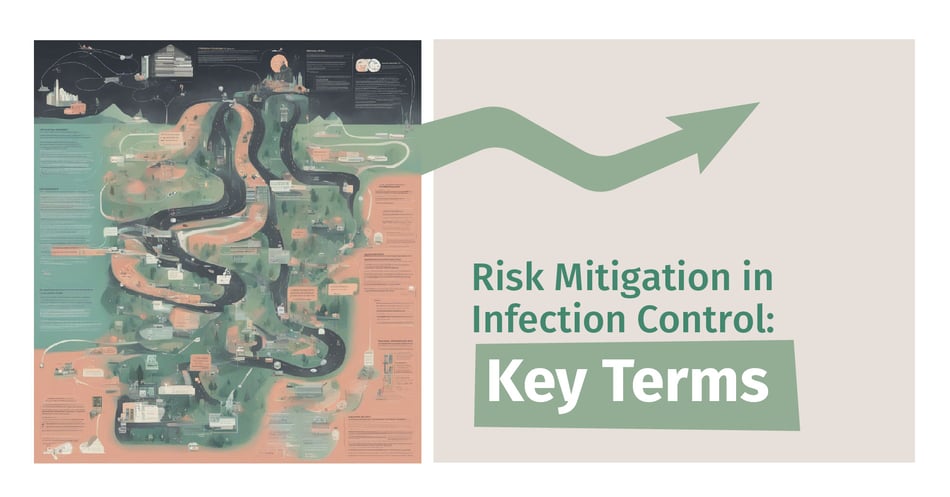Risk Mitigation and Infection Control: Key Terms

![risk mitigation key terms [Recovered]-01](https://blog.eoscu.com/hs-fs/hubfs/Marketing/EOScu_Blog/Blog_Headers/risk%20mitigation%20key%20terms%20%5BRecovered%5D-01.jpg?width=1959&height=1026&name=risk%20mitigation%20key%20terms%20%5BRecovered%5D-01.jpg) In the world of risk mitigation, there are a number of established concepts that encompass the many ways to avoid harm. These concepts also apply to infection prevention and control, and help us identify areas of greater vulnerability, areas where we can be proactive, and finally, areas where we can lessen harm should the worst occur. In today's post, we will look at these key concepts and begin to the lay the foundation of the idea of risk mitigation in infection prevention and control.
In the world of risk mitigation, there are a number of established concepts that encompass the many ways to avoid harm. These concepts also apply to infection prevention and control, and help us identify areas of greater vulnerability, areas where we can be proactive, and finally, areas where we can lessen harm should the worst occur. In today's post, we will look at these key concepts and begin to the lay the foundation of the idea of risk mitigation in infection prevention and control.
Risk mitigation can be divided into what can be done before harm occurs and what can be done to lessen harm during the harm event.
Before an Event
- Risk Assessment: The process of identifying, analyzing, and evaluating potential risks. The Centers for Disease Control offers Infection Control Assessment tools to aid a facility in this process, as do all the major industry associations. The results of these assessments must be an integral part of staff training and education. The result is called an ICRA, or Infection Control Risk Assessment.
- Risk Management: The process of identifying, assessing, and prioritizing risks followed by coordinating and implementing resources to minimize, monitor, and control the probability or impact of unfortunate events. In healthcare, this is "a complex set of clinical and administrative systems, processes, procedures and reporting structures designed to detect, monitor, assess, mitigate, and prevent risks to patients" (NIH, 2020). Specifically for infection prevention, risk management includes all the protocols and interventions plus surveillance, reporting, and feedback.
- Risk Mitigation: The action of reducing the severity, likelihood, or impact of a risk. This is "an ongoing process of preparation and prevention of events" (Leapfrog, 2023). Risk mitigation may vary by facility, depending on demographics served and the results of the risk assessment. Investment in biocidal surfaces would fit into risk mitigation, as it takes a known risk (infection from contaminated surfaces) and reduces the risk by putting a biocidal material at the source of the contamination (overbed tables, bed rails, etc.).
- Contingency Planning: Developing a course of action to address potential risks and their impacts if they occur. This advanced plan allows for better decision-making during an event or crisis. A part of this might include Business Continuity Planning, planning and preparing for the continuation of critical business functions in the event of a disaster or unforeseen event. For example, a contingency plan would detail how surgeries could continue take place safely in the event of an outbreak.
During An Event/Ongoing
- Crisis Management: The process of managing an unexpected event that poses a serious threat to an organization's reputation, operations, or stakeholders. For a hospital, this includes both clinical and administrative tasks.
- Risk Response Strategies: Predefined actions to address identified risks, including avoidance, transfer, mitigation, or acceptance. These will vary from event to event and would be detailed in the contingency planning process.
- Risk Monitoring and Control: Continuous tracking and adjustment of risk management activities to ensure effectiveness and adaptability to changing circumstances. A huge part of this for infection control is the collection and analysis of data, including hand hygiene compliance, infection rates, environmental culturing, and patient outcomes.
Overall Facility Culture
- Risk Tolerance: The amount of risk an organization or individual is willing to endure before taking action to reduce or mitigate it. This idea should not be overlooked when it comes to infection prevention and control. Just how many infections are "acceptable risk" to a facility? How high to rates have to go before changes are made? For some facilities, no preventable infection is acceptable, and those facilities takes steps to make this belief a reality. For others, other priorities influence infection risk tolerance, including financial priorities. Thankfully, there are interventions that can reduce the risk of infection without significant impact to financial burdens of hospitals, including biocidal materials that require not additional staff time or any ongoing investments.
What does risk mitigation mean to you? How would you describe the risk tolerance at the facilities where you have worked or received care? Share your thoughts in the comments below!
![EOScu Logo - Dark - Outlined [07182023]-01](https://blog.eoscu.com/hubfs/Eoscu_June2024/Images/EOScu%20Logo%20-%20Dark%20-%20Outlined%20%5B07182023%5D-01.svg)




